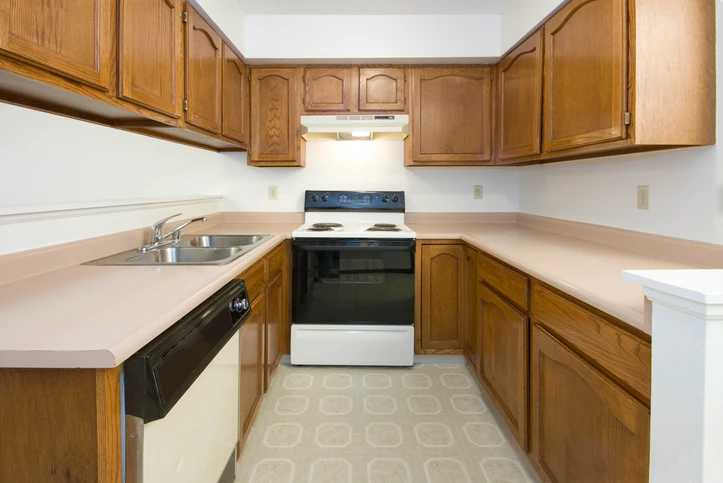
Painting Outdated Countertops, Cabinets and Floors is a Cost-Effective Option, but Not a DIY Job
You’re either one of two minds about Formica: It’s delightfully retro or tacky and outdated. If you lean toward the latter, you’re likely considering options for updating your antiquated bathrooms and kitchen. But your budget and your desire for butcher block countertops and shaker cabinets are at odds. So, what’s a homeowner to do?
You might be surprised to learn that painting Formica and laminate surfaces is an affordable alternative to replacing them. Done right, painting over this tired material can deliver stylish results. But don’t break out your brush and roller just yet. Painting Formica takes a tremendous amount of prep work to ensure the coat bonds with the surface. And not just any paint will do. Bathrooms and kitchens are heavily trafficked spaces, so you’ll need something that can stand up to harsh conditions.
Formica: An Origin Story
Invented in 1912 by Cincinnati electrical engineers Daniel O’Conor and Herbert Faber, Formica was originally developed as a substitute for mica (hence the name), a mineral used for electrical insulation. Basically, it was an early version of electrical tape. But Formica’s application extended far beyond electrical wires.
During WWII, war efforts relied heavily on the hardy material for automobile parts, airplane propellers and bombs. But a technological innovation would bring Formica to the fore as a decorative surface for kitchen interiors. Paper laminated with melamine proved to be a game changer, enabling the company to produce thick sheets resembling wood grain, marble and even quirky motifs like the company’s signature Skylark pattern, which looks like a series of haphazardly arranged boomerangs.
By the early 1950s Formica became synonymous with greasy spoon dinners and soon found its way into residential kitchens across the country. Resistant to heat, abrasions and moisture, Formica countertops became ubiquitous. It didn’t hurt that Formica was cigarette-proof, either. People were smokers back then. The pastel plastic countertops remained fashionable throughout the 70s and it’s even making something of a comeback today.
Of course, the kitschy look isn’t for everyone. Thankfully, it can be painted over if you’re willing to put in the work.
Painting Formica
Preparation is key to painting any surface, but Formica presents certain challenges. To start, you’ll need to rough up every square inch of surface with 150 to 250 grit sandpaper. Take your time to ensure there are no smooth spots remaining. This will be especially difficult if your counters have a metal band around the edges, as so many 1960s kitchens do. You’ll want to sand right up to that edge without scuffing up the metallic material.
Next, you’ll fill in scratches, dents and knicks with an epoxy putty for a smooth countertop. Remember, all those little imperfections will show up under a fresh coat, especially if you go with a darker color.
You’ll tape all the edges you do not want painted, being certain that you’ll have pin-straight lines.
You’ll apply at least one coat of primer. Primer will let the paint adhere to the Formica surface. Be sure to let the primer dry after each coat.
Next, you’ll apply a strong, durable paint, applying the layer in long, smooth strokes. It may take two coats.
Don’t forget your top coat! This protective sealant will keep surfaces looking glossy and prevent scratches and scuffs.
Painting Laminate Floors
Laminate floors do not always look like the wood grains they’re supposed to resemble. And they tend to show their age faster than real wood. Paint can breathe new life into laminate floors but, like Formica, you’ll have your work cut out for you.
You’ll follow all the same steps above, but floors are a larger surface area than countertops, so do not expect to knock out this project over the course of a weekend.
Leave This Job to the Pros
Yes, you can paint Formica countertops and cabinets. You can paint laminate floors, too. But this job can go south if you’re not careful. When you turn to the pros at you can spare yourself from a DIY disaster. Plus, our color experts will advise you on the best hues to cover up those dated surfaces.
Ready to give your bathroom and kitchen a fresh new look? Contact us today at to schedule your free consultation!


